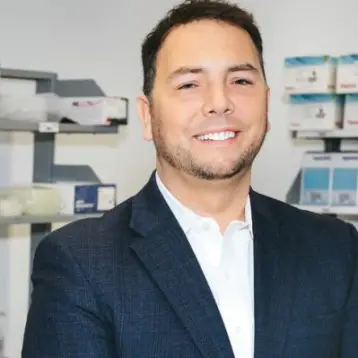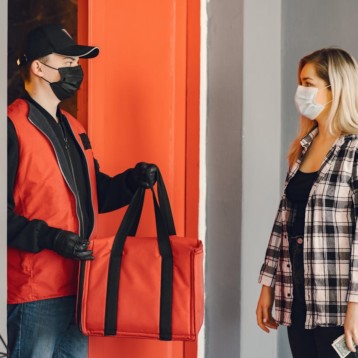Cancer, the world’s #1 killer
|
Finding a cure for cancer is probably the most ambitious goal that lies ahead for 21st-century medical science. Decades of intense research and hundreds of billions of dollars spent annually on research and medication have provided invaluable and detailed information on the causes, mechanisms, and ways to inhibit or even cure cancer. But despite the overwhelming wealth of information, the fact remains that cancer has now officially become the number-one killer in the developed world, according to the World Health Organization.
Cancer is a disease in which a single cell, somewhere in the body, begins to abnormally multiply, forming a tumor. Over time, the cells in the tumor—all originating from a single cell—acquire certain traits that allow them to continue proliferating. If not treated in time, the cells can leave their original tissue and invade other healthy tissue in a process called metastasis. The patient eventually may die not of the tumor itself, but from damage caused to other adjacent tissues. If detected early, the tumor can be surgically removed; very often, by the time the cancer is diagnosed, the cells have already metastasized, making it virtually impossible to remove the tumor.
Traditional oncology
Traditional oncologic therapies include radiation and chemotherapy. The object of these treatments is to sustain damage to cells, eventually killing them, with a specific focus on rapidly replicating cells. In this way, cancer cells are damaged or inhibited, but so too are healthy replicating cells, such as blood stem cells, intestinal cells, and sperm-producing cells in the testes. Other newer approaches use antibodies against certain molecules that tumor cells secrete, inhibiting, for example, blood vessel growth. Many therapies are aimed at stopping or slowing the growth of a tumor, but not exterminating it. This may lead to long-term remission, but there is always the chance that a single cell may develop a resistance to the drug and continue to multiply, making necessary the administration of even higher and deadlier doses of drugs. These drugs themselves are dangerous and often lead to the death of the patient.
In other words, cancer can be stalled but not cured. To cure cancer completely, every single cancer cell in the body must be exterminated. Alternatively, replication of a few residual cancer cells, known as cancer stem cells, must be blocked or controlled. Because a million cancer cells together are no larger than a pinhead, a patient’s blood tests, X-rays, and other imaging can appear normal following conventional treatment, but may actually contain millions of cancer cells waiting for the end of chemo to explode back into action.
Where the immune system fails…
Immune therapy for cancer exploit’s the body’s natural army of white blood cells that have the ability to seek and destroy renegade cells.
When our cells are invaded with a foreign pathogen, such as a virus, the body has its own innate defense mechanisms that are targeted against those particular cells, killing them and preventing the virus’ spread to healthy cells. These immune mechanisms spring into action only when there is a foreign invader, and the immune system is programmed to not attack the body’s own cells. The reason cancer cells are not destroyed by the body’s defense systems is that cancer cells are the body’s own cells and are therefore seem by the body as itself, not a foreign invader; hence, cancer cells are immune from the immune system, sneaking under the radar of the body’s immune defenses. Also, cancer cells use methods to repress the function of lymphocytes, or white blood cells, further neutralizing their capacity to respond to the malignant cells. However, cleverly manipulating the immune system to attack cancer cells, and using a few additional modalities to target malignant cells, can now be achieved in many types of cancers.
Immune therapy, an inside look
|
Professor Shimon Slavin, of the newly established International Center for Cell Therapy & Cancer (ICTC) at the Tel Aviv Medical Center in Israel, supports the notion that in order to destroy the very last cancer cell, the immune system must be activated at a stage at which the tumor has been reduced to a minimum using conventional therapy—a stage Slavin calls “minimal residual disease”—then, when the cancer metastases are small and very often undetectable, the immune system can be prompted to take out the residual cancer cells.
Boosting the patient’s immune system to battle cancer
|
The simplest way to use the immune system to fight cancer is by administering an additional dose of substances that can excite the immune system following conventional treatment. This therapy most likely works by eliminating factors that negate development of an immune response against cancer. One of these substances belongs to the aspirin family. Surprisingly, people who use aspirin or similar nonsteroid anti-inflammatory agents on a regular basis have a statistically smaller chance of developing cancer. Another stimulating chemical is a natural signaling molecule called interleukin-2 (IL-2). These kinds of treatment regimens completely cured mice with leukemia and even greatly facilitated the immunization of mice for inoculated metastatic breast cancer. More importantly, the use of IL-2 in conjunction with cell therapy improved the outcome and vitality of human cancer patients with leukemia.
In an attempt to minimize the number of residual cancer cells, high-dose chemotherapy can have many side effects and unfortunately may also involve the destruction of the patient’s bone marrow, so traditionally, prior to administration of such aggressive treatment, bone marrow or blood-derived stem cells after extraction from the marrow must be collected and cryopreserved ahead of time and transplanted anew after the chemotherapy and radiation have hopefully destroyed the tumor. This is called autologous bone marrow transplantation (BMT) or stem-cell transplantation. Bone marrow contains the stem cells that produce the cells that constitute the immune system. Some of these lymphocytes, particularly the T-cells and natural killer cells, can be aroused with substances like IL-2 prior to their transplantation so that when they enter the patient’s body, they will have the ability to attack and destroy any remaining cancer cells rapidly and effectively.
Bringing in the foreign legion mercenaries
|
The problem with the autologous BMT is that in many cases, the procedure is unlikely to destroy the “last” cancer cells. The immune system that develops from the patient’s own stem cells is made of the same cells that had previously failed to destroy the cancer, so they may fail the next time too.
Theoretically, if one were to take a tumor from a cancer patient and transplant it into a healthy stranger, the stranger would not develop cancer. This is key to understanding the idea of immune cancer therapy. The reason he would not develop cancer is that within a few days his immune system would zealously attack the foreign tumor cells, destroying them, similar to how a transplanted organ is often rejected by the host when the immunological match between the donor and the host poor.
Professor Slavin’s groundbreaking idea was to use lymphocytes (immune system cells that can destroy other cells) collected from the blood of a different healthy person as mercenaries against the cancer, activate them in the lab, and administer them to the patient. The idea being, if a healthy person’s lymphocytes have the ability to destroy a foreign tumor in their own body, why not use them to kill a tumor in someone else’s body?
Hurdles on the way to lymphocyte infusion
Cell therapy by activated donor lymphocytes can be a very effective and simple procedure against “minimal residual disease.” This is because activated donor lymphocytes only need a few days to eliminate a small number of malignant cells on board, until they are rejected by the patient’s own immune system. However, donor lymphocytes acting against cancer must survive for many months in patients with large tumors.
|
In order for the treatment by donor lymphocytes to succeed in fighting the more bulky tumors, the patient has to be tolerant of the donor’s cells or the cells will be destroyed by the patient’s immune system before they can get a chance to destroy the tumor. This tolerance can be achieved by replacing the patient’s bone marrow while minimizing the number of cancer cells, then transplanting bone marrow or blood stem cells from the donor. After the donor’s newly grafted blood stem cell population has settled in, the patient will have become tolerant to the donor’s lymphocytes. At this stage the patient should be ready for the transfusion of activated lymphocytes from the donor, the cells that should finish the cancer off. . This treatment is called donor lymphocyte infusion (DLI).
These kinds of treatments have already been successfully used on thousands of patients worldwide. The first and one of the most astounding cases where DLI was used to treat cancer in a human patient was a two-and-a-half-year-old toddler with leukemia who had gone through all types of conventional therapy, including radiation four times the lethal dose and bombardment with some of the most poisonous drugs available, including a lethal dose of whole body irradiation. He managed to survive the treatment, but the cancer returned with a tumor mass in his blood and marrow with visible tumor masses on his forehead and next to his trachea, obstructing his airway. As a last resort he was given an injection of blood from his sister once a week for six weeks. The tumor masses disappeared and the boy was completely cured. He is alive today, more than 20 years later. Since then, many patients, most with hematological malignancies and some with metastatic solid tumors, were successfully treated by Slavin using either short-lived donor lymphocytes or long-lived donor lymphocytes following tolerance induction by stem-cell transplantation.
Choose your weapons carefully
|
The previous case was made possible because the boy underwent BMT and therefore his immune system was tolerant to the sister’s blood. Since then, DLI methods have improved, and today, using clever techniques, DLI can be performed without a BMT or immunological match. In fact, mismatched donor lymphocytes are usually preferred because the more the mismatch, the better the anticancer efficacy of the donor lymphocytes.
The cells from the donor needed for safe battling of the cancer in the patient’s body are of the type “Natural Killer” (NK) cells. Whereas there are other cells called T-cells that would attack all of the patient’s cells, including the healthy ones, in a process called graft vs. host disease (GVHD). No GVHD is caused by donor NK cells—even if they’re fully mismatched. Hence, a separation of an undesired effect of GVHD from the beneficial graft-versus-tumor effects can be averted if the NK cells are separated from the T-cells and only they are injected into the patient. This can be done by positive selection of NK cells using antibodies bound to metal beads that will specifically bind only NK cells, or simply by removing the T-cells by a similar method using antibodies against T-cells. Selection or removal of cells bound to metal beads is accomplished by a magnet using a special apparatus called CliniMACS.
Chemo reduced to minimum
|
Many cancer patients unfortunately die not of the tumor, but of complications from the high doses of medication needed to kill the cancer. Professor Slavin has developed a protocol, using lymphocytes from any intentionally mismatched donor, which attempts to eliminate cancer cells escaping conventional anticancer approaches at an early stage of the disease. Slavin’s approach intends to reduce the cumulative amount of drugs given to a patient, minimizing the risk of the patient developing resistance to further chemotherapy, and treating them while their immune system is still intact. The patient is treated with surgery, radio and chemotherapy according to standard protocols, which normally result, initially, in a stage of minimal residual disease. This treatment allows a mild suppression of the immune system, leading to a prolonged yet limited survival of activated donor lymphocytes.
New hope for cancer therapy at the ICTC
Drawing from years of experience in basic science, successful protocols using preclinical animal models of human diseases, and pilot clinical trials, additional pioneering modalities are available for cancer patients in need of treatment beyond the norm.
Vaccine for cancer
|
In addition to fighting cancer with foreign donor lymphocytes, Professor Slavin’s hope is to be able to generate an immune response against cancer to create long-lasting immunity against residual or re-emerging malignant cells, should cancer cells reappear. This, he believes can be accomplished by taking some of the cancer cells from the tumor when it is surgically removed, modifying them slightly, and injecting them back into the patient, hoping that the immune system would be activated by its “altered self,” or cells that will now be regarded as foreign. Alternatively, cancer cells of the same kind, but from other patients, growing in the laboratory and sharing cell surface molecules with the patient’s cancer cells, cannot multiply. But they can be used as a vaccine to induce an immune response against the patient’s own cancer cells.
Guided missiles home in on cancer
|
Cancer cells resemble normal “self” cells, but very often they also express upon their membranes proteins or markers that are unique to certain types of cancer. Thus, cancer cells can be singled out and targeted by clever homing mechanisms, much like an antitank missile homes in on metal or heat. Antibodies that can specifically bind to cancer cells are connected to NK cells or T-cells. When injected into the patient’s body, they bring the killer cell into close proximity of the cancer cell, leading to the extermination of the latter. Both the NK cells and T-cells can be described as bombs, with the antibody as the radar or guiding mechanism and the cancer cell as the target, thus once the bomb is delivered to the target by the antibody, it should destroy the cancer cell.
A brand-new, highly sophisticated upgrade of this immunologic missile is an antibody that can deliver at the same time not one, but two different cells of the immune system to the target. The antibody can bind a cancer cell, an NK cell, and a T-cell—bringing them all together to smart-bomb the cancer cell. This antibody also has the ability to start an immune response, enabling the patient’s own immune system to reject the cancer cells in the future, should they return.
Anticancer missiles manufactured in cattle
An antibody that binds a T-cell on the one hand and a human melanoma (an aggressive type of skin cancer that is almost incurable) cell on the other, can now be mass-produced in transgenic cows cloned by a German scientist, Dr. Gottfried Brem, working in collaboration with Slavin. Genetically engineered, these cows can produce a single antibody, which binds a T-cell and a Melanoma cell, meaning that all the antibodies that are extracted from the blood of that cow will be of the type that destroy human melanoma cells. This unique ability will be passed on to their offspring, enabling an unlimited supply of anticancer smart-bombs.
Using harmless cancer seeking viruses for treatment of cancer
|
A highly interesting approach in fighting cancer is the use of cancer seeking poultry viruses that are pathogenic for chicken, but harmless in man. Poultry viruses belonging to the Newcastle disease virus (NDV) family can sometimes target cancer cells selectively, resulting in replication inside the malignant cell and finally killing the cell, while releasing additional viruses that destroy neighboring cells. Such viruses can also penetrate the brain and result in dramatic anticancer effects in patients with this most-deadly type of cancer — brain cancer of the type glioblastoma multiforme or similar gliomas. In most cases, treatment with NDV is not associated with any significant side effects, suggesting a possible important future strategy for treatment of cancer cells resistant to all available conventional modalities with a safe biological tool.
Today thousands of patients worldwide are being saved by cleverly manipulating the immune system to fight cancer. The future cancer medicine holds is a more personalized approach to cancer therapy; recognizing the unique needs of each patient and in parallel, the type of cancer, examining the profile of proteins expressed by the cancer and, according to this, choosing the correct “smart bomb” to seek and destroy the cancer cells. In addition, cancer treatment must consist of a combination approach because each primary cancer and certainly the metastases comprise different cell types with different sensitivity to any available treatment, with cancer stem cells being the most resistant and difficult to eliminate due to their inactive state.
|
Despite the many successes in the field of innovative anticancer immune-based therapy, it is still not considered the standard care, and most of the patients that have undergone these kinds of treatments were “last resort” patients, everything else having failed. “This is too late for a cure to be expected,” says Slavin. “One can only anticipate more successful treatments if they were administered at an early stage of the disease against minimal tumor burden.”
“Taken together,” he concludes, “although immune-based and other targeted anticancer procedures available at ICTC hold a beacon of optimism for cancer medicine in the future, prospective randomized clinical trials are urgently needed in order to confirm the anticipated efficacy of such procedures allowing us to return our trust to the best remedy by our inbuilt Mother Nature tools, our own adaptive and innate immune system. Accomplishing such a goal will require effective cooperation between surgeons, oncologists, hematologists and scientists working in research laboratories and clean rooms, as well as more flexibility by regulatory authorities in view of the urgent need to introduce new modalities against man’s number-one killer: cancer.”
Interview with Professor Shimon Slavin
Interview with Professor Shimon Slavin, Medical & Scientific Director, the International Center for Cell Therapy & Cancer (ICTC) at the Tel Aviv Medical Center, Israel.
Q: When and why did you become interested in immune-therapy? And when did you realize that it could indeed cure cancer?
A: I was interested in immunotherapy because I was disappointed from the results of treatment of patients’ hematological malignancies and metastatic solid tumors with conventional anticancer modalities, which cause a lot of side effects on the one hand, and very little benefit on the other. Being involved transplantation immunobiology it was clear to me that once the immune system can recognize a tissue as “non self” rejection is imminent, regardless of the volume of the tissue. This working hypothesis gave me an idea that if I can use an allogeneic immune system that will recognize cancer cells as “non self” immune reaction against such undesirable tissue could be most effective, not leaving a single cell alive, exactly as is the case when an allograft is placed with no post grafting immunosuppressive treatment.
Q: Immune-therapy for many years has been mostly bad-mouthed, owing to fairly disappointing results. Why do you feel that, despite all the failures, immune-therapy holds undiscovered promise?
A: It is true that wishful thinking based on preclinical animal models resulted in great hope in immunotherapy, while clinical experience was mostly disappointing. However, in view the strong rationale and successful outcome in patients with hematological malignancies it became clear to me that immunotherapy has a lot of potential once we understand the rules of the game. Most efforts with immunotherapy until my time were based on the use of patients own immune system cells, trying to divert them to induce reactivity against patient’s own cancer cells. Unfortunately, this procedure seemed insufficient because if patients own immune system cells could recognize the first cancer cell as being different from normal “self,” a potential enemy, that patient will not have cancer to start with. The fact was that the first cancer cell and daughter cells then after, evaded the immune system successfully, and in addition probably down regulated the immune system and even induced tolerance or unresponsiveness to the emerging cancer cells. Taken together, our working hypothesis suggested that instead of relying on patient lymphocytes, it would be much easier to break the tolerance that exists between patient’s immune system and his own cancer cells using allogeneic lymphocytes, which are likely to be alloreactive. That simple concept suggested to me that perhaps the better way to use anticancer effector cells therapeutically would be to use allogeneic immune system cells, especially if such cells can circulate permanently in the host, following induction of transplantation tolerance by prior engraftment of donor stem cells. Durable engraftment of donor lymphocytes will allow ample of time to eliminate cancer cells recognized as “non-self.”
A: NK cells kill using special receptors that activate such cells depending also on harmony with receptors that can suppress the reactivity of such cells. Since cancer cells usually down regulate MHC molecules they are more susceptible to NK cell mediated cytolysis. There are other factors too, some better understood than others, but the fact remains that NK cells can be used as potential killers of cancer cells while usually not harming normal cells.
Q: Do you think it is possible to use animal lymphocytes to fight human cancer instead of needing a human donor?
A: Unfortunately animal lymphocytes do not fight well against human target cells and therefore it is unlikely that such cells can be used for immunotherapy except perhaps if we use primates that are closest to humans.
It is very difficult, for example, to induce graft-vs.-host disease with human lymphocytes against mice, whereas the mirror image experiment cannot be done…
Q: If a cancer patient is interested in receiving immune-therapy, is it available to anyone, or is it only performed at certain centers?
A: Immunotherapy is considered experimental treatment and therefore available only in centers of excellence that are involved with experimental medicine. Since most immunotherapy procedures are not considered evidence-based medicine, many major centers are not applying immunotherapy as a standard of care and unless believers familiar with basic immunology involved with patient’s care will be involved in providing care using methods based on innovative immunotherapy for patients in need under their care, in full collaboration with basic scientists and cell biologists, no progress is to be anticipated.
Q: What, in your view, are the major bottlenecks that need to be passed technologically to make immune-therapy the first choice for treatment of cancer?
A: In order to make sure the experts in the field will accept immunotherapy as a legitimate treatment, let alone treatment of choice for patients with full resistance to conventional anticancer modalities, several reproducible prospective randomized clinical trials must be accomplished. To do such studies takes a lot of collaborative effort and funding and many years of observation while closely observing recruited patients on a long tern basis. Obviously, no company is likely to support treatment program based on Mother Nature tool – the lymphocytes. Also, referring oncologists will not refer patients that are suitable for immunotherapy because they do not believe in methods that are not proven effective. Yet, there is no way to prove a method is effective unless oncologists will cooperate and send patients for clinical trials. This is catch 22, which explains why there is such a slow progress in the field. Another important factor is due to the fact that pharmaceutical companies that usually are behind large and expensive clinical trials are not particularly interested in using mother nature tool – the lymphocyte – because they rather prefer to support standard off-the-shelf anticancer agents. Unfortunately such studies are most difficult to produce:
immunotherapy is one form of personalized treatment method, whereas the name of the game likely to draw the attention and financial support of the pharmaceutical industry is to develop standard medications suitable for all patients with the same disease category.
Q: The idea of DLI curing cancer seems almost too good to be true, but where is the catch? What are the major drawbacks?
A: Donor lymphocyte infusions (DLI) seem to be effective for some patients, particularly for the treatment of diseases such as chronic myelogenous leukemia and some others. DLI may not be effective against rapidly developing relapsing malignancies and also against bulky disease, and the reasons could be some of the following:
1. When DLI is done between MHC compatible donors and recipients the anticancer effect of such immunotherapy may not be optimal due to the intentional compatibility between the effecter cells and their targets.
2. Following allogeneic stem cell transplantation GVHD must be prevented by immunosuppressive treatment for several months and any treatment that prevents GVHD or treatment that is used to treat GVHD also neutralizes the potential beneficial effects of the T-cells included in the DLI, both being mediated by donor T-cells.
3. Since the beneficial effects of DLI are directly related to alloreactivity of donor cells against host alloantigens, benefits of DLI are frequently if not nearly always associated with acute and chronic GVHD which can be hazardous or even lethal. Consequently, once treatment is applied, the benefits of DLI may be minimal and time consuming, while the risk of GVHD will be ongoing progressively.
4. Not every cancer cell is a good antigen-presenting cell and therefore, non-immunogenic cancer cells may not stimulate donor T-cells sufficiently well.
5. For DLI to be effective donor effecter cells must recognize cancer cells through antigen presentation and some cancer cells may not express antigenic determinants in association with class II which is the way helper T-cells recognize their relevant stimulatory peptide.
A: I believe that treatment of cancer will continue to challenge scientists and clinicians for the foreseeable future. Cancer is a family of diseases and each type of cancer may have to be dealt with individually. The incidence of cancer is constantly growing worldwide due to constantly increasing life expectancy on the one hand, and due to many other acquired environmental factors, some known and most as of yet unknown. Future progress for the treatment of cancer is likely to be based on combinatorial approach, in full consideration of cancer specific markers and patient specific factors. Each primary cancer and certainly metastatic lesions are not made of one type of cell and therefore several modalities working in concert would be required in order to treat effectively rapidly replicating cancer cells, cancer stem cells, the host-derived scaffold that holds and supports cancer cell growth, especially cancer nourishing blood vessels enhanced by the growing tumor cells, a phenomenon known as angiogenesis. Taken together, adequate control of cancer metastases will depend on our ability to control all of the above factors that will be required for elimination of the rapidly proliferating cancer cells as well as the hidden, quiescent cancer stem cells, both by activation of anticancer effector mechanisms on the one hand, while in parallel, suppression or down regulation of negative signals that negate such anticancer effector mechanisms.






















